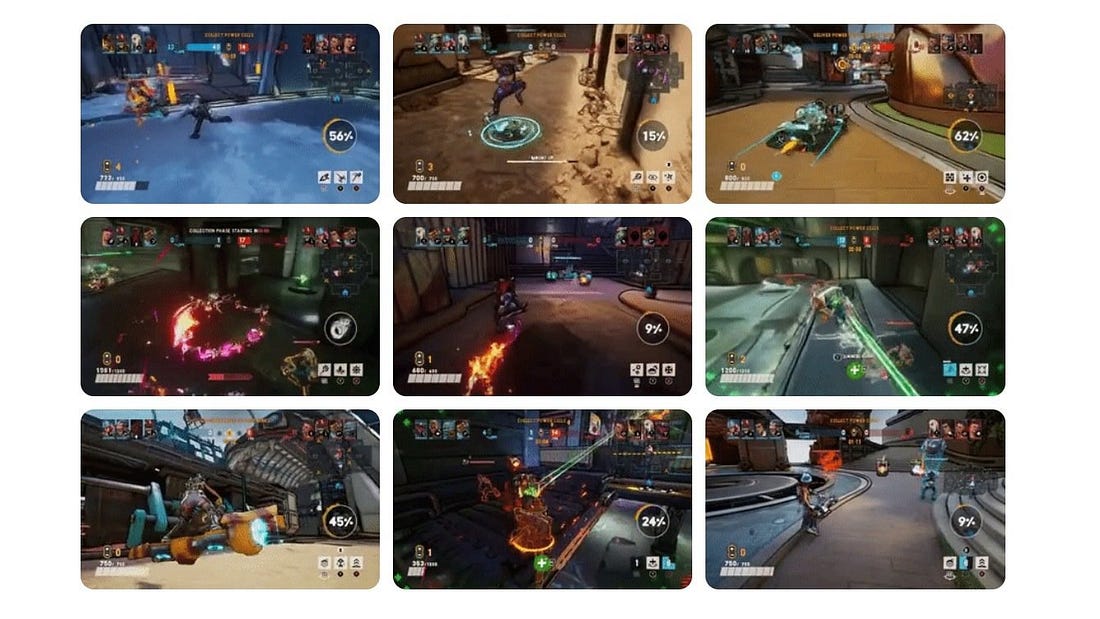The Sequence Radar #496: Microsoft Muse Can Generate Entire Games After Watching You Play
Was this email forwarded to you? Sign up here The Sequence Radar #496: Microsoft Muse Can Generate Entire Games After Watching You PlayThe new AI model represents a milestone in gameplay idetation.Next Week in The Sequence:Our series about RAG continues with a deep dive into GraphRAG which was recently created by Microsoft. Speaking of Microsoft, we discuss the amazing rStar-Math technique to improve math reasoning in LLMs. The engineering section dives into Composio which has become one of the most popular stacks to integrate tools with LLMs. Finally, the opinion section discusses whether we are seeing a renaissance in reinforcement learning, or not ;) You can subscribe to The Sequence below:📝 Editorial: Microsoft Muse Can Generate Entire Games After Watching You PlayGames have played a monumental role in the evolution of AI. From creating training environments to simulating real world conditions, games represent incredible catalyzers on AI learning. A new field known as world action models is rapidly emerging as a field to combine games and AI. Microsoft just dropped an ecising research in this area with a model that can create games after watching human players. Sounds crazy? Let’s discuss. Microsoft Research has introduced Muse, a cutting-edge generative AI model designed to revolutionize gameplay ideation by generating both game visuals and controller actions. Known as a World and Human Action Model (WHAM), Muse acts as a digital collaborator that understands and extends video game dynamics using real human gameplay data. This initiative reflects a growing trend of integrating AI to enhance—not replace—the creative process within the gaming industry. Muse is trained on human gameplay data from the Xbox game Bleeding Edge, learning from over 1 billion images and controller actions—equivalent to more than seven years of continuous gameplay. By analyzing this extensive dataset, Muse can generate complex gameplay sequences that remain consistent and engaging over extended periods. Its architecture enables it to predict how a game might evolve from an initial sequence, capturing the nuanced interplay of visuals, player actions, and game physics. A standout feature of Muse is its interactive prototype—the WHAM Demonstrator. This tool empowers developers to load visual prompts and generate multiple gameplay continuations, allowing for hands-on exploration of different scenarios. This iterative approach helps developers quickly visualize, tweak, and refine gameplay concepts, unlocking new levels of creative experimentation. To ensure Muse’s output meets the demands of game development, Microsoft Research evaluates the model across three key characteristics:
With Muse, Microsoft is paving the way for a future where AI serves as a creative partner—expanding the boundaries of what’s possible in game design while keeping human creativity at the forefront. 🔎 AI ResearchSWE-LancerIn SWE-Lancer: Can Frontier LLMs Earn $1 Million from Real-World Freelance Software Engineering, OpenAI introduces SWE-Lancer, a benchmark designed to evaluate model performance in real-world, freelance software engineering tasks, mapping model capabilities to actual monetary value and assessing complex, full-stack software engineering and management skills. The SWE-Lancer Diamond is a public evaluation split containing $500,800 worth of tasks. The AI Co-ScientistResearchers from Google Cloud AI Research, Google Research, Google DeepMind, Houston Methodist, Sequome, Fleming Initiative and Imperial College London, and Stanford University introduce an AI co-scientist, a multi-agent system built on Gemini 2.0, designed to assist scientists in generating novel hypotheses and research proposals. The system uses a generate, debate, and evolve approach to improve hypothesis quality, with validations in drug repurposing, novel target discovery, and explaining mechanisms of bacterial evolution and anti-microbial resistance. MuseIn the paper World and Human Action Models towards gameplay ideation, researchers from Microsoft Research introduce Muse, a new generative model called World and Human Action Model (WHAM). Muse is designed to generate consistent and diverse gameplay sequences and persist user modifications, which are identified as critical for creative ideation in game development. AutellixIn the paper Autellix: An Efficient Serving Engine for LLM Agents as General Programs researchers from UC Berkeley, Google DeepMind, and Shanghai Jiao Tong University introduce Autellix, an LLM serving system designed to minimize end-to-end latencies by treating programs as first-class citizens. Autellix intercepts LLM calls, enriches schedulers with program-level context, and uses scheduling algorithms to preempt and prioritize calls based on previously completed calls, improving throughput by 4-15x compared to state-of-the-art systems. Can Small Models Reason?In the paper Small Models Struggle to Learn from Strong Reasoners, researchers from University of Washington, Carnegie Mellon University , Western Washington University uncover that small language models (≤3B parameters) do not consistently benefit from long chain-of-thought (CoT) reasoning or distillation from larger models3. The paper introduces Mix Distillation, a strategy that balances reasoning complexity by combining long and short CoT examples, which significantly improves small model reasoning performance3. Qwen2.5-VLIn the paper Qwen2.5-VL Technical Report researchers from Alibaba Group introduce Qwen2.5-VL, the latest flagship model of the Qwen vision-language series, which demonstrates advancements in visual recognition, object localization, document parsing, and long-video comprehension. The model introduces dynamic resolution processing and absolute time encoding, allowing it to process images of varying sizes and videos of extended durations with second-level event localization. 🤖 AI Tech ReleasesGrok 3xAI unveiled Grok 3, its most advanced model with impressive benchmark results. SmolVLM2Hugging Face open sourced SmolVLM2, a video foundation model that can run in small devices. PaliGemma 2 mixGoogle released PaliGemma 2 mix, a vision language model built on its Gemma family. 📡AI Radar
You’re on the free list for TheSequence Scope and TheSequence Chat. For the full experience, become a paying subscriber to TheSequence Edge. Trusted by thousands of subscribers from the leading AI labs and universities. |
Older messages
📖 Mastering LLM Inference
Thursday, February 27, 2025
[Free Guidebook] ͏ ͏ ͏ ͏ ͏ ͏ ͏ ͏ ͏ ͏ ͏ ͏ ͏ ͏ ͏ ͏ ͏ ͏ ͏ ͏ ͏ ͏ ͏ ͏ ͏ ͏ ͏ ͏ ͏ ͏ ͏ ͏ ͏ ͏ ͏ ͏ ͏ ͏ ͏ ͏ ͏ ͏ ͏ ͏ ͏ ͏ ͏ ͏ ͏ ͏ ͏ ͏ ͏ ͏ ͏ ͏ ͏ ͏ ͏ ͏ ͏ ͏ ͏ ͏ ͏ ͏ ͏ ͏ ͏ ͏ ͏ ͏ ͏ ͏ ͏ ͏ ͏ ͏ ͏ ͏ ͏ ͏ ͏ ͏ ͏ ͏ ͏ ͏ ͏ ͏ ͏ ͏
The Sequence Knowledge #497: Microsoft's GraphRAG is One of the Newest RAG Techniques
Thursday, February 27, 2025
The methods enables RAG in an interconnected graph of documents ͏ ͏ ͏ ͏ ͏ ͏ ͏ ͏ ͏ ͏ ͏ ͏ ͏ ͏ ͏ ͏ ͏ ͏ ͏ ͏ ͏ ͏ ͏ ͏ ͏ ͏ ͏ ͏ ͏ ͏ ͏ ͏ ͏ ͏ ͏ ͏ ͏ ͏ ͏ ͏ ͏ ͏ ͏ ͏ ͏ ͏ ͏ ͏ ͏ ͏ ͏ ͏ ͏ ͏ ͏ ͏ ͏ ͏ ͏ ͏ ͏ ͏ ͏ ͏ ͏ ͏ ͏ ͏ ͏
The Sequence Engineering #498: Integrating Tools with AI Agents Using Composio
Thursday, February 27, 2025
Hundreds of connectors that can be integrated using a simple programming framework. ͏ ͏ ͏ ͏ ͏ ͏ ͏ ͏ ͏ ͏ ͏ ͏ ͏ ͏ ͏ ͏ ͏ ͏ ͏ ͏ ͏ ͏ ͏ ͏ ͏ ͏ ͏ ͏ ͏ ͏ ͏ ͏ ͏ ͏ ͏ ͏ ͏ ͏ ͏ ͏ ͏ ͏ ͏ ͏ ͏ ͏ ͏ ͏ ͏ ͏ ͏ ͏ ͏ ͏ ͏ ͏ ͏ ͏ ͏
The Sequence Knowledge #487: A RAG that Assesees Itself
Friday, February 14, 2025
A technique for robust RAG implementations. ͏ ͏ ͏ ͏ ͏ ͏ ͏ ͏ ͏ ͏ ͏ ͏ ͏ ͏ ͏ ͏ ͏ ͏ ͏ ͏ ͏ ͏ ͏ ͏ ͏ ͏ ͏ ͏ ͏ ͏ ͏ ͏ ͏ ͏ ͏ ͏ ͏ ͏ ͏ ͏ ͏ ͏ ͏ ͏ ͏ ͏ ͏ ͏ ͏ ͏ ͏ ͏ ͏ ͏ ͏ ͏ ͏ ͏ ͏ ͏ ͏ ͏ ͏ ͏ ͏ ͏ ͏ ͏ ͏ ͏ ͏ ͏ ͏ ͏ ͏ ͏ ͏ ͏ ͏
The Sequence Engineering #488: Txtai, Maybe the Simplest Way to do Embeddings
Friday, February 14, 2025
A simple and developer friendly framework for building embeddings into LLM apps. ͏ ͏ ͏ ͏ ͏ ͏ ͏ ͏ ͏ ͏ ͏ ͏ ͏ ͏ ͏ ͏ ͏ ͏ ͏ ͏ ͏ ͏ ͏ ͏ ͏ ͏ ͏ ͏ ͏ ͏ ͏ ͏ ͏ ͏ ͏ ͏ ͏ ͏ ͏ ͏ ͏ ͏ ͏ ͏ ͏ ͏ ͏ ͏ ͏ ͏ ͏ ͏ ͏ ͏ ͏ ͏ ͏ ͏ ͏ ͏
You Might Also Like
Re: Tomorrow's Password Class: How to sign up!
Thursday, February 27, 2025
Hi there, Do you reuse passwords? Do you struggle to remember unique passwords across accounts? Have you tried setting up a password manager but found it to be a hassle? You might not realize how
Documenting Event-Driven Architecture with EventCatalog and David Boyne
Thursday, February 27, 2025
If you're wondering on how to document Event-Driven Architecture, or you don't know that you should, I have something for you. We discussed with David Boyne, why data governance practices and
wpmail.me issue#708
Thursday, February 27, 2025
wpMail.me wpmail.me issue#708 - The weekly WordPress newsletter. No spam, no nonsense. - February 27, 2025 Is this email not displaying correctly? View it in your browser. News & Articles Shaping
Hackers stole 1Password logins - here's how
Thursday, February 27, 2025
Amazon AI races ahead; Research agents; Smartwatch trade-in -- ZDNET ZDNET Tech Today - US February 27, 2025 thief stealing passwords Hackers stole this engineer's 1Password database. Could it
New Golang-Based Backdoor Uses Telegram Bot API for Evasive C2 Operations
Thursday, February 27, 2025
THN Daily Updates Newsletter cover ⚡ LIVE WEBINAR ➟ Building Resilient Identity: Reducing Security Debt in 2025 Attacks Evolve, So Can Your Defenses--Learn How to Mitigate Risk and Optimize Identity
Reminder: What developer productivity metrics actually measure
Thursday, February 27, 2025
You are receiving this email because you subscribed to microservices.io. Considering migrating a monolith to microservices? Struggling with the microservice architecture? I can help: architecture
⚡ THN Weekly Recap: Google Secrets Stolen, Windows Hack, New Crypto Scams & More
Thursday, February 27, 2025
From Google espionage to crypto scams, this week's Cyber Recap uncovers it all—read more now ͏ ͏ ͏ ͏ ͏ ͏ ͏ ͏ ͏ ͏ ͏ ͏ ͏ ͏ ͏ ͏ ͏ ͏ ͏ ͏ ͏ ͏ ͏ ͏ ͏ ͏
Guest-post: Open-source Python Development Landscape
Thursday, February 27, 2025
30 must-know tools for Python development ͏ ͏ ͏ ͏ ͏ ͏ ͏ ͏ ͏ ͏ ͏ ͏ ͏ ͏ ͏ ͏ ͏ ͏ ͏ ͏ ͏ ͏ ͏ ͏ ͏ ͏ ͏ ͏ ͏ ͏ ͏ ͏ ͏ ͏ ͏ ͏ ͏ ͏ ͏ ͏ ͏ ͏ ͏ ͏ ͏ ͏ ͏ ͏ ͏ ͏ ͏ ͏ ͏ ͏ ͏ ͏ ͏ ͏ ͏ ͏ ͏ ͏ ͏ ͏ ͏ ͏ ͏ ͏ ͏ ͏ ͏ ͏ ͏ ͏ ͏ ͏ ͏ ͏ ͏ ͏
⚙️ IBM's AI can reason, now
Thursday, February 27, 2025
Plus: A bit of AI legislation
Post from Syncfusion Blogs on 02/17/2025
Thursday, February 27, 2025
New blogs from Syncfusion ® How to Add a Context Menu to .NET MAUI ListView? By Jayaleshwari N This blog explains how to implement a context menu in the .NET MAUI ListView control with code examples.



